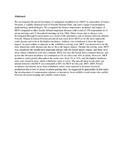| dc.description.abstract | We investigated the perceived impact of malignant catarrhal fever (MCF) to pastoralists in Isinya Division, a wildlife dispersal area of Nairobi National Park, and used a range of participatory epidemiology methodologies. We compared the relative importance, incidence and impact of MCF compared to other locally defined important diseases with a total of 158 respondents in 11 group meetings and 21 household meetings in July 2004. Direct losses due to disease were investigated through lowered prices as a result of the emergency sale of disease-infected animals.
Overall, Maasai in Isinya Division perceived east coast fever (ECF) to be the most important cattle disease and to have the highest incidence. Anthrax was considered to have the largest impact. In areas within or adjacent to the wildebeest calving zone, MCF was perceived to be the most important cattle disease and also to have the largest impact. Outside the calving zone, MCF was considered the fourth-most important disease with the fourth largest impact, and these were areas where wildebeest were less common. MCF was also the fourth-most common disease, and across the Division incidence was estimated at 5% in calves and 10% in adults. However, MCF incidence varied greatly throughout the study area, from 3% to 12%, and the highest incidence risks were found in areas where wildebeest came to calve. The percent drop in sale price per animal infected with MCF was estimated at 50% for MCF for the year 2003–2004.
Forced avoidance movements away from wildebeest calves were reported to decrease livestock production due to loss of access to prime grazing sites. As suggested by pastoralists in this study, the development of compensation schemes or incentives from wildlife would reduce the conflict between livestock keeping and wildlife conservation. | en |

